National Depression Glass Association
Preserving America's Glass Manufacturing Heritage
H. C. Fry Glass Company Advertisements
H. C. Fry Glass was established in 1901 by Henry Clay Fry. The factory was located in Rochester, PA. H.C.Fry was quite old (61) when he founded his company, which continued into the Depression years. However, the death of H. C. Fry (in 1929) combined with the dismal economy, resulted in closure by the receivers in 1933.
Initially the company made crystal glass blanks for cutting by other companies, and Fry did their own high quality cutting as well. The quality of their glass and its high lead content resulted in some of the finest cut crystal ever made in the USA. Fry continued to make cut crystal into the early 1920s. Fry also produced intricate etchings, on very thin blown glass, including some beautiful patterns that were still being announced as late as 1931.
Heat-resistant oven glass was made by H. C. Fry from 1916 onwards, under license from Corning. Initially, Fry oven ware was lime green colored, but in 1921 they introduced opalescent ovenware and kitchenware. This glass is always marked with the name FRY and other descriptive words. Fry kitchen ware was produced in clear and colored glass as well as opalescent.
Complete dinner sets and tea sets were also made by Fry, along with candlesticks and bowls for table decoration. They were offered in colored or opalescent or crystal glass, and a range of decorations were applied. These included crackle effects, glass threading, colored lines, silver overlay, gold overlay or trim, enamel decoration, black or colored applied feet (sometimes petal shaped), and swirled knops connecting up the stems. Tableware became an increasing important part of the company's production in the 1920s.
Fry Glass company used their high quality opalescent glass as the basis for an art glass line known as "FOVAL." Products included teapots, coffee-pots, jugs, candlesticks, vases, compotes, bowls, cups, saucers, plates, goblets, etc. They were either plain opalescent glass, or had blue or green handles or feet or decorative trim added. A few pieces were produced in jade green or delft blue. Fry Art Glass was hand blown and fire polished, with the pontils polished out. Some items such as lids were pressed.
Click on any of the thumbnail photos to see a larger image.
| Thumbnail | Description of Advertisement |
|---|---|
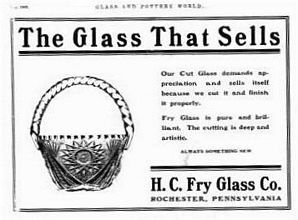 |
Fry Cut Glass, 1905 |
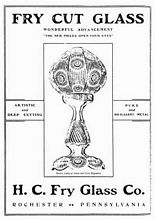 |
Fry Cut Glass, 1905 |
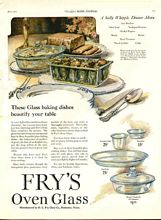 |
Fry Oven Glass, 1922 |
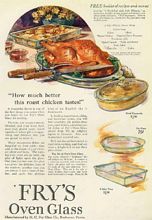 |
Fry Oven Glass, 1922 |
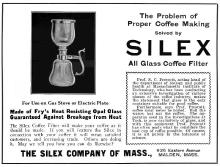 |
Silex Advertisement featuring Fry Glass, 1922 |